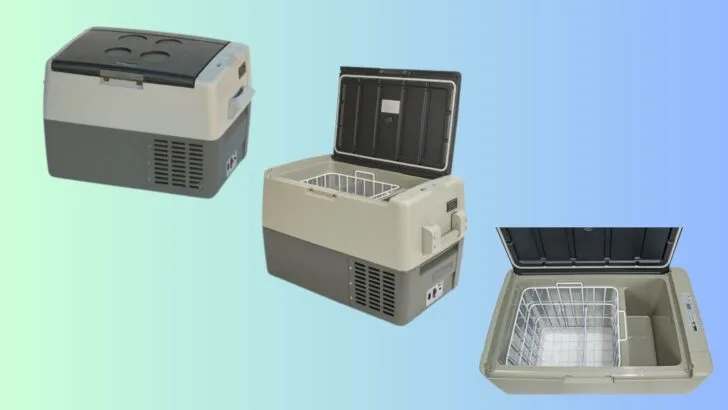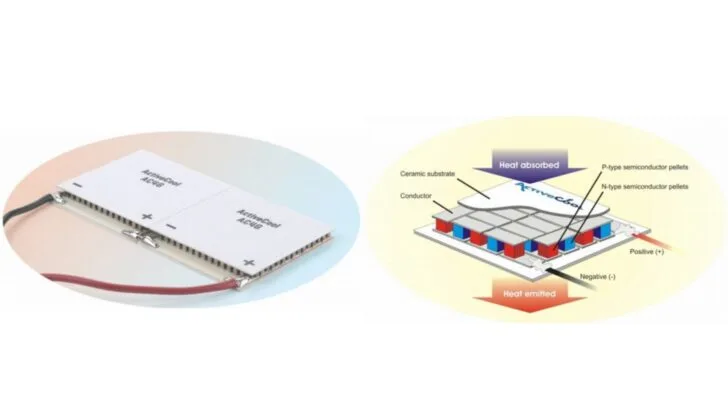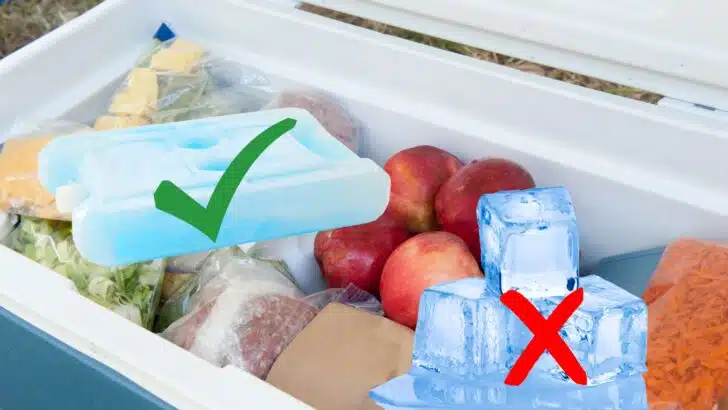We’ve read a number of articles about 12V coolers, but most of them conflate them with portable refrigerators, which are not the same thing. They combine 12V compressor refrigerators and fridge/freezers in the same article. A 12V cooler is <strongnot a compressor fridge.
12V coolers use a different cooling method than 12V compressor fridges do, and the cooling results are different.
In today’s post, we want to clarify exactly what you’re getting when you buy a 12V cooler.
A 12V cooler may be the perfect cooling box for your food and beverages when you’re on a road trip or enjoying a day at the beach.
But, without understanding what a 12V cooler actually is and does, your purchase could be disappointing.
Let’s dive in to see if a 12V cooler is the right cooling box for your purposes.
What Is a 12V Cooler?
A 12V cooler uses a thermoelectric device to keep a container (the cooler box itself) cool.
In essence, the thermoelectric device keeps the container holding your food and beverages cool, as ice would in a regular ice cooler.
The purpose of a 12V cooler is to replace the need for ice with the ability to cool on DC power.
So, a 12V cooler plugs into a 12V DC (“cigarette lighter”) plug in your car or RV, and your 12V battery supplies the power required for the unit to cool.
What you need to know is just how cool the unit can get. This is where you’ll find a significant difference between a 12V thermoelectric cooler (the topic of this post) and a 12V compressor refrigerator.
Some say it’s a difference in semantics – one is called a “12-volt cooler” and the other is called a “12-volt mini fridge” or “12-volt refrigerator/freezer.”
But it goes beyond semantics. There’s a significant difference in how a thermoelectric cooler works vs how a compressor cooler/fridge works.
They’re not the same, and they don’t offer the same degree of cooling. The fact that so many articles use the terms interchangeably is likely why you see so many negative 12V cooler reviews. People expect a 12V cooler for cars to perform like a portable compressor refrigerator.

These portable compressor fridges cool to below freezing, offer variable temperature control and use more power than a 12V cooler.
Let’s dive into how the two are different and how they perform. Once you understand this, you’ll know exactly what you’re getting when you buy either type of unit to provide cold drinks and keep your food cold on your road trip.
How Does a Thermoelectric 12V Cooler Work?
As we noted above, a 12V thermoelectric cooler uses power from your car battery (or any 12V/DC battery). The cooler has a 12V power cord that plugs into any 12V cigarette-style power outlet.
When it’s plugged in, a 12V cooler will bring the temperature anywhere from 30-40 degrees below the ambient (outside) temperature.
So, if the outside/ambient temperature is 90°F on a summer day, for example, the interior of your 12V cooler will cool to around 50-60°F, depending on the model. (12V coolers are insulated differently, so some cool down and retain that cool temp better than others.)
Here’s how a thermoelectric car cooler (12V) works:
Inside the cooler, you’ll find something called a Peltier plate. This plate is what cools the interior. Basically, thermoelectric coolers are solid-state heat pumps that use the Peltier effect to move heat.
The Peltier plate is named after a French physicist named Jean Charles Athanase Peltier, who discovered in the 1840s that heat or cooling could be created when an electric current is forced thru two different conductors.
Peltier found that you could build a semiconductor and sandwich it between two different metals and then plug it into a power source to create a cooling (or heating) device.

Here you see diagrams demonstrating the Peltier effect – a principle of thermoelectric cooling. (Source: ActiveCool)
This is the principle that a 12V thermoelectric cooler uses to lower temperature. (For much more technical detail on how thermoelectric cooling works, see the ActiveCool website.)
If you’re interested in more of a deep-dive into how a thermoelectric cooler works, you can watch this video:
Unlike a portable compressor refrigerator, a 12V cooler has no temperature control. It simply cools the interior of the box 30-40 degrees lower than the ambient temperature… whether that’s the temperature in your car or outside on the beach, etc.
Compressor refrigerators use 12V power, but they work differently, using a small compressor to generate their cooling power, and, most importantly, cooling all the way down to the temperature you set.
Some compressor fridges even offer dual zone cooling, meaning that one side can be set to as a fridge, and the other can be set as a freezer. (There are also units that are portable freezers only. For more information, see our post on portable freezers.)
Do 12 Volt Coolers Work Well?
The answer to this question depends on what you need a 12V cooler to do.
If you need to keep your food, beverages, and maybe even medications cooled to a certain temperature… or frozen… at all times, then the answer is no. A 12V cooler won’t work well for you.
If you want to keep some drinks and sandwiches cold in your car or RV for a day at the beach, and the contents of the cooler will be safe at 30-40 degrees below the ambient temperature, then a 12 volt cooler (which is far less expensive than a 12V portable compressor fridge) should work fine for your purposes.
You might not want to put temperature-sensitive foods (like dairy) or medications in a 12V cooler, though, unless you’re sure the ambient temperature will remain below 77° or so.
How Cold Do 12V Coolers Get?
It’s worth repeating that the most cooling you’ll get from a 12V cooler is 40°F less than ambient temperature. That’s the ideal amount of cooling you can expect from a thermoelectric cooler.
This type of cooler works best in environments around 77°F or less. If you’re going to be in a very hot climate, or if you’re planning to keep food in your 12V cooler in a hot car in the dog days of summer, it’s highly unlikely you’ll be satisfied with the cooling ability of a 12V thermoelectric cooler.
This is because if the ambient temp (outdoors or inside your vehicle) climbs to 110°F, for example, the interior of your cooler will be, at best, about 70°F.
Likewise, if the summer heat brings temps of 90°F, your thermoelectric cooler will cool its interior to around 50°F.
Now, that may be exactly the extent of cooling you’re looking for, and if that’s the case, then a 12V cooler may work very well for you.
As we noted earlier, a 12V cooler is far less expensive than a 12V compressor fridge.
12V thermoelectric coolers also use less power than a compressor fridge, so that’s another plus.
However, if you’re looking for a unit with temperature control that will keep the interior of your fridge at a food-safe temperature, you’ll need to opt for a 12V compressor refrigerator. A 12V thermoelectric cooler will simply not cool well enough for this.
Can You Put Ice In a 12 Volt Cooler?
You can put ice packs in a 12V cooler. However, if you put ice inside a 12V thermoelectric cooler, it’s possible that it could damage the Peltier plate when the ice melts.
Once that happens, your cooler may no longer work.

It’s best to use ice packs in a 12V cooler rather than ice that could melt and possibly damage the Peltier plate.
The beauty of a 12V cooler is that it leaves behind the need for ice, meaning you escape the likelihood of a wet mess being created inside your cooler as the day rolls along and the ice melts.
Final Note
A 12V thermoelectric cooler is a step up from a standard cooler that uses ice.
They allow you to keep things cold/cool for longer without using ice, so your food doesn’t get soggy, waterlogged, or even spoiled from sitting in water/melted ice. And you don’t lose the storage space that ice takes up.
So, these are great for use in your car for day trips, or even as a backup fridge to keep beverages cold for a longer trip in your RV (beverages that won’t spoil if they do get warmer than refrigerator temps).
Some people also use them for trips to places like Costco or other grocery stores that are far enough away from home that a 12V cooler helps to keep items cold on the way home from shopping.
Note that some (not all) 12V thermoelectric coolers can also function as heaters. Here again, they’ll only keep the interior warm to a certain degree. But if that’s all you’re looking for, it could serve that purpose as well.
While this isn’t a post specifically comparing various 12V thermoelectric coolers, we want to include a few links to some popular models here to give you an idea of the type of units we’re referring to.
But, the most important point to be clear on is that a portable 12V cooler is not the same as a portable 12V compressor refrigerator.
Again, we suspect that misleading articles that conflate the two different types of cooling systems are generally the main reason you’ll find so many negative reviews on these units.
- 14L 12v cooler/warmer lets drivers save money and time by enjoying food and drinks on the go inside your vehicle, reduce or eliminate stops at fast...
- Keep food and beverages cool without messy ice, or keep them warm instead; unit holds up to 12 soda cans; standard size water bottles also fit inside...
- COOLER 40QT TE W/O PWR CD COLD C001
- COOLER 40QT TE W/O PWR CD COLD C001
- Swing-up bale handle with comfort grip for easy carrying
- Molded-in side handles for two handed carrying or lifting. Capacity-32 12-oz cans; 26 quarts (24 liters)
- ROBUST COOLING: The electric cooler cools up to 32-40°F (18-22°C) below ambient temperature
- 24 LITERS LARGE CAPACITY: Store ! (30) 12 oz cans ! Inner dimensions are 12.8” x 8.8” x 13.1”; The removable divider makes small items like...
As long as your expectations of a unit are realistic, one of these coolers may serve your purposes well.
Free RVing Tips, Tricks, Reviews, Giveaways & More
Subscribe to our daily newsletter! We’ve been full-time RVers for 20 years (!) and share everything we’ve learned about RVing in our daily blog posts. Join our online community to receive a wealth of great RVing knowledge delivered right to your inbox.
Whether this is your first time on the road or you’re a seasoned full-timer, you’ll love the wide range of RVing topics we cover. Don’t miss a single article or any of our famous RV gear Giveaways — Subscribe today!






Larry
Monday 15th of May 2023
Thermoelectric coolers take a long time to get cold. Best to plug them in the day before they are needed.
J Tutton
Monday 15th of May 2023
Thank you for your article. I have used a thermoelectric cooler on long road trips for many years. I feed raw food to my dogs and I try and take it with me. What I have found works best to keep food safe is to keep some of that food frozen or add ice packs. The cooler stays much colder. I also take it inside a hotel if I am overnighting. I agree, though, it should not be used for sensitive foods over long periods of time.